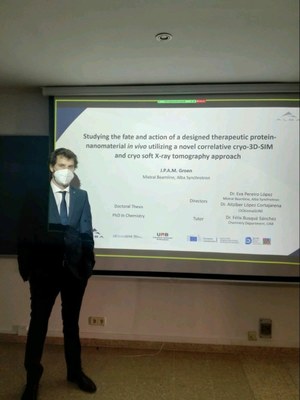Do you want to keep up to date? Subscribe to our newsletter. 1mail every 2months! |
 |
Cerdanyola del Vallès (Barcelona), 19th January 2022. Last Friday, the PhD student Johannes Groen from the Universitat Autònoma de Barcelona (UAB) and the ALBA Synchrotron defended his thesis entitled “Studying the fate and action of a designed therapeutic protein-nanomaterial in vivo utilizing a novel correlative cryo-3D-SIM and cryo soft X-ray tomography approach”. The defence took place in the UAB premises in a semi-presential mode.
The thesis was supervised by Dr. Eva Pereiro López, scientist in charge of MISTRAL beamline at the ALBA Synchrotron, Dr. Aitziber López Cortajarena from CIC BiomaGUNE and Dr. Félix Busqué Sánchez from the Chemistry Department of the UAB. Groen’s work counted with the collaboration of professionals from the research centres CIC BiomaGUNE (San Sebastián), IBBTEC (Santander) and CNB-CSIC (Madrid), in addition to ALBA scientists.
A therapeutic protein-nanomaterial was designed to inhibit the collagen overproduction after a myocardial fibrosis event. Indeed, the number of people affected by cardiac fibrosis has been increasing in last decades, both because of the ageing of the baby-boom population and the rise of unhealthy habits. As there is no preventive or curative treatment at the moment, Groen’s study offers very promising results to save lives.
The samples were prepared at the ALBA Synchrotron and the experiments were performed at the IBBTEC research centre, at ALBA (in the MISTRAL and MIRAS beamlines) and at the Diamond Light Source (the national synchrotron facility at the UK). These experiments combined cryo-3D correlative fluorescent light and X-ray tomography to locate, for the first time, the nanomaterial and to obtain high resolution information on the cellular morphological changes after treatment. This pave the way for the introduction of nanomaterial-based drugs and nanomedicine into the clinic.
Groen's work was published in October 2021 in the Royal Society of Chemistry journal.
This PhD thesis is part of the 1st call of the Doctoral Training Programme in Functional Advanced Materials (DOC-FAM), a H2020-MSCA-COFUND project coordinated by ICMAB-CSIC in collaboration with four partner research institutions from the area: IMB-CNM, IREC, ALBA Synchrotron and ICN2.

Johannes Groen in his PhD thesis defence at the UAB.
Related article: SYNCHROTRON LIGHT UNVEILS THE EFFICACY OF A NEW NANOMATERIAL FOR CARDIAC FIBROSIS
With the collaboration of Fundación Española para la Ciencia y la Tecnología. The ALBA Synchrotron is part of the of the Unidades de Cultura Científica y de la Innovación (UCC+i) of the FECYT and has received support through the FCT-20-15798 project.





